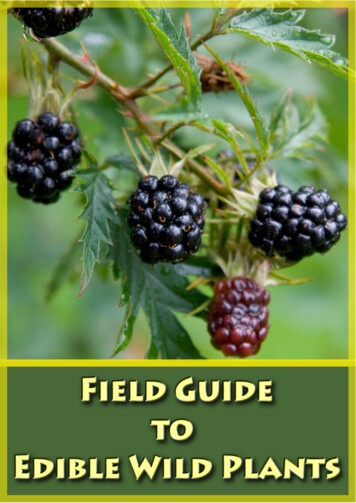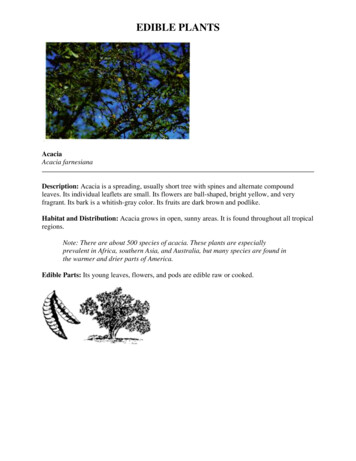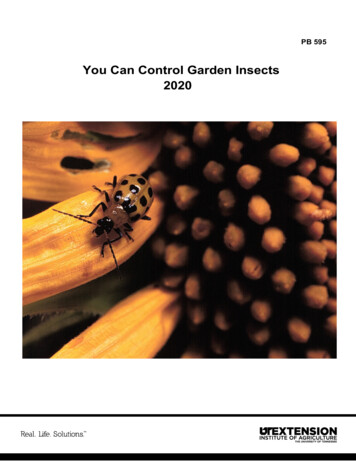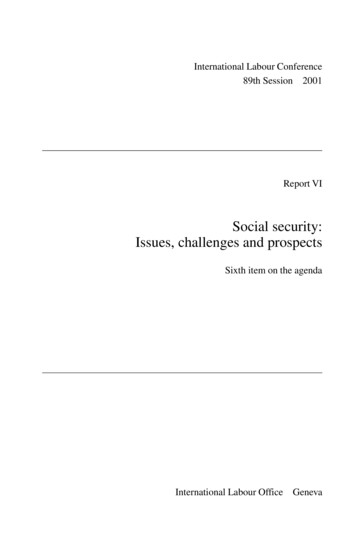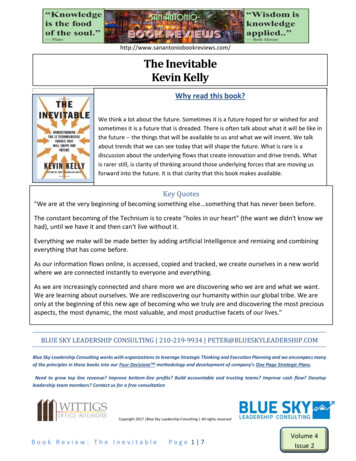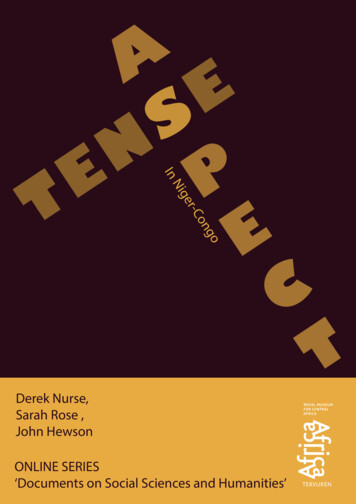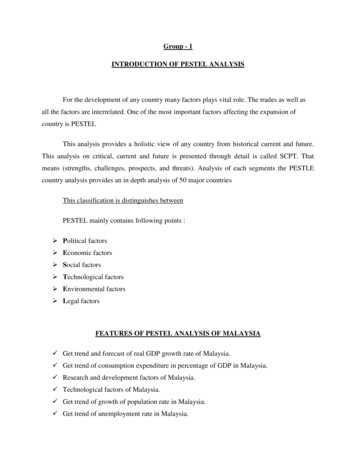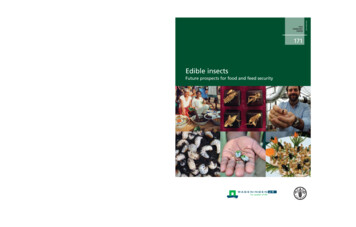
Transcription
1.04cm spinefor 208pg on90g eco paperFAO FORESTRY PAPER171Edible insectsEdible insectsFuture prospects for food and feed securityThis publication describes the contribution of insects tofood security and examines future prospects for raisinginsects at a commercial scale to improve food and feedproduction, diversify diets, and support livelihoods in bothdeveloping and developed countries. It shows the manytraditional and potential new uses of insects for directhuman consumption and the opportunities for andconstraints to farming them for food and feed. It examinesthe body of research on issues such as insect nutrition andfood safety, the use of insects as animal feed, and theprocessing and preservation of insects and their products.It highlights the need to develop a regulatory framework togovern the use of insects for food security. And it presentscase studies and examples from around the world.Edible insects: future prospects for food and feed securityEdible insects have always been a part of human diets,but in some societies there remains a degree of disdainand disgust for their consumption. Although the majorityof consumed insects are gathered in forest habitats,mass-rearing systems are being developed in manycountries. Insects offer a significant opportunity to mergetraditional knowledge and modern science to improvehuman food security worldwide.Future prospects for food and feed securityEdible insects are a promising alternative to theconventional production of meat, either for direct humanconsumption or for indirect use as feedstock. To fully realizethis potential, much work needs to be done by a wide rangeof stakeholders. This publication will boost awareness ofthe many valuable roles that insects play in sustainingnature and human life, and it will stimulate debate on theexpansion of the use of insects as food and feed.ISBN 978-92-5-107595-1 ISSN 0258-61507 8 9 2 5 10 7 5 9 5 1I3253E/1/04.13FAO9ISSN 0258-6150171171FAOFORESTRYPAPER
1.04cm spinefor 208pg on90g eco paperCover photos, clockwise from top left:Women selling caterpillars in Bangui, Central African Republic (P. Vantomme)Gold-painted crickets on top of Belgian chocolates (P. Vantomme)Black soldier fly in a mass-rearing unit (L. Heaton)Appetizers prepared with insects (T. Calame)Coleoptera species used as a food colorant (A. Halloran)Palm weevil larvae (O. Ndoye)
Edible insects:future prospects forfood and feed securitybyArnold van HuisJoost Van ItterbeeckHarmke KlunderEsther MertensAfton HalloranGiulia MuirandPaul Vantommefood and agriculture organization of the united nationsRome, 2013FAOFORESTRYPAPER171
The designations employed and the presentation of material in thisinformation product do not imply the expression of any opinion whatsoeveron the part of the Food and Agriculture Organization of the United Nations(FAO) concerning the legal or development status of any country, territory, cityor area or of its authorities, or concerning the delimitation of its frontiers orboundaries. The mention of specific companies or products of manufacturers,whether or not these have been patented, does not imply that these havebeen endorsed or recommended by FAO in preference to others of a similarnature that are not mentioned.The views expressed in this information product are those of the author(s) anddo not necessarily reflect the views or policies of FAO.ISBN 978-92-5-107595-1 (print)E-ISBN 978-92-5-107596-8 (PDF) FAO 2013FAO encourages the use, reproduction and dissemination of material in thisinformation product. Except where otherwise indicated, material may becopied, downloaded and printed for private study, research and teachingpurposes, or for use in non-commercial products or services, provided thatappropriate acknowledgement of FAO as the source and copyright holder isgiven and that FAO’s endorsement of users’ views, products or services is notimplied in any way.All requests for translation and adaptation rights, and for resale and othercommercial use rights should be made via www.fao.org/contact-us/licencerequest or addressed to copyright@fao.org.FAO information products are available on the FAO website (www.fao.org/publications) and can be purchased through publications-sales@fao.org.
iiiContentsForeword. ixAbbreviations. xAuthors’ preface. xiAcknowledgements. xiiExecutive Summary. xiii1. Introduction. 11.1 Why eat insects?. 21.2 Why FAO?. 22. The role of insects. 52.1 Beneficial roles of insects for nature and humans. 52.2 Entomophagy around the world. 92.3 Examples of important insect species consumed. 202.4 Important insect products. 293. Culture, religion and the history of entomophagy. 353.1 Why are insects not eaten in Western countries?. 353.2 Why were insects never domesticated for food?. 373.3 Negative attitudes towards insects. 393.4 History of entomophagy. 404. Edible insects as a natural resource. 454.1 Edible insect ecology. 454.2 Collecting from the wild: potential threats and solutions. 454.3 Conservation and management of edible insect resources. 484.4 Semi-cultivation of edible insects. 514.5 Pest management. 555. Environmental opportunities of insect rearing for food and feed. 595.1 Feed conversion. 605.2 Organic side streams. 605.3 Greenhouse gas and ammonia emissions. 625.4 Water use. 645.5 Life cycle analysis. 645.6 Animal welfare. 655.7 Risk of zoonotic infections. 655.8 “One Health” concept. 666. Nutritional value of insects for human consumption.676.1 Nutritional composition. 676.2 Beef versus insects: an example of the mealworm. 746.3 Insects as part of diets . 766.4 Sustainable diets. 796.5 Edible insects in emergency relief programmes. 79
iv7. Insects as animal feed. 897.1 Overview. 897.2 Poultry and fish fed with insects. 907.3 Key insect species used as feed . 938. Farming insects. 998.1 Definitions and concepts . 998.2 Insect farming. 998.3 Insect farming for human consumption. 1018.4 Insect farming for feed. 1038.5 Recommendations on insect farming. 1039. Processing edible insects for food and feed.1079.1 Different types of consumable products. 1079.2 Industrial scale processing.11010. Food safety and preservation.11710.1 Preservation and storage.11710.2 Insect features, food safety and antimicrobial compounds.11910.3 Allergies. 12311. Edible insects as an engine for improving livelihoods.12511.111.211.311.4Insects as a part of the minilivestock sector. 125Improving local diets. 126Access, tenure and rights to natural capital. 127Inclusion of women. 12812. Economics: cash income, enterprise development, marketsand trade.13112.112.212.312.412.5Cash income.131Enterprise development. 133Developing markets for insect products. 135Market strategies. 137Trade. 13813. Promoting insects as feed and food.14113.1 The disgust factor.14113.2 Drawing on traditional knowledge. 14713.3 Role of stakeholders. 14914. Regulatory frameworks governing the use of insects forfood security.15314.1 Major barriers faced. 15414.2 Legal framework and standardization. 15615. The way forward.161References.163Further reading .187
vBoxes1.1What are insects?. 12.1Outbreaks of the brown planthopper. 52.2 Common insect products and services. 62.3 Examples of cultural entomology. 72.4 Example of national insect diversity: species eaten in theCentral African Republic. 102.5Use of sound in harvesting larvae.112.6Maguey worms. 122.7Beekeeping around the world. 132.8 Ahuahutle, Mexican caviar. 152.9Wild food consumption by the Popoloca people of Los ReyesMetzontla Puebla, Mexico . 192.10 Yansi sayings, Democratic Republic of the Congo. 212.11 Red palm weevil. 222.12 Merging traditional knowledge and new technologies for termiteharvesting in Kenya . 242.13 Power cuts harm Uganda’s edible grasshopper business. 282.14 Controversial use of cochineal. 302.15 Using scale insects to enhance honey production. 313.1Sky prawns and sea crickets. 363.2 Examples from Mali and the United States. 383.3 Entomophagy and modern-day Christianity. 403.4Edible insects through the centuries. 414.1Lao People’s Democratic Republic. 464.2 Wild harvesting in Asia and the Pacific: past, present and future. 464.3 Mopane and other African caterpillars. 474.4 Insects and biodiversity in Brazil. 504.5 Effect of fire management and shifting cultivation on caterpillarpopulations. 534.6The case of the cockchafer bug: from agricultural pest to delicacyto conservation controversy. 555.1Ecodiptera project. 616.1The FAO/INFOODS food composition database for biodiversity. 676.2 Proteins and amino acids (“food chemistry”). 686.3 Fatty acids. 716.4 Witchetty grub . 716.5 Don Bugito: creative and traditional Mexican food cart . 776.6WinFood: alleviating childhood malnutrition by improved use oftraditional foods . 807.1International Feed Industry Federation and FAO: looking for new,safe proteins. 897.2Fish for non-food uses. 907.3Which insects are currently used in animal feed?. 91
vi7.4Chicken consumption leading to human infection with highlydrug-resistant ESBL strains. 917.5Increasing the sustainability of freshwater prawn productionin Ohio. 948.1Dual production systems (fibre and food): the example ofthe silkworm. 998.2 Biological control and natural pollination. 1008.3 Insect proteins in space. 1028.4 Difficulties in rearing crickets in the Netherlands. 1049.1Termites: processing techniques in East and West Africa. 1099.2Environmental economics.1139.3Application of edible insects: insects as the missing link indesigning a circular economy.11410.1 Processing the mopane caterpillar for human consumption.11810.2 The stink bug Nezara robusta in southern Africa.12110.3 Bogong moths in Australia. 12210.4 The allergy–hygiene hypothesis. 12411.1 The red palm weevil (Rynchophorous ferrugineus) as an importantsource of nutrition and livelihood in New Guinea. 12711.2 Cambodian spiders. 12811.3 Edible insect consumption and indigenous peoples. 12912.1 Harvesting, processing and trade of mopane caterpillars. 13212.2 Wholesale markets in Thailand. 13312.3 Feasibility study before starting a street-food business. 13312.4 The Dutch Insect Farmers Association. 13412.5 FAO Diversification Booklet 18, Selling Street and Snack Food. 13612.6 Ethnic foods through migration: the export of caterpillars fromAfrica to France and Belgium. 13912.7 Japanese trade in wasps. 13913.1 How can people with an aversion to insects understand and acceptthat insects are palatable?.14113.2 Edible insect cookbooks. 14213.3 Established approaches used in education for sustainabledevelopment. 14313.4 The Food Insects Newsletter. 14413.5 International knowledge-sharing between developing countrieson the use of edible insects in diets. 14813.6 The Nordic Food Lab. 15013.7 Konchu Ryori Kenkyukai.15114.1 FAOLEX. 15314.2 Barriers to market establishment in the European Union. 15514.3 Codex Alimentarius. 15614.4 Definition of novel food by the European Commission. 158
viiFigures2.1Recorded number of edible insect species, by country. 92.2 Number of insect species, by order, consumed worldwide. 102.3 Monthly rainfall (top) and monthly occurrence of meals of fish,caterpillars and game in 15 consecutive months in the Lake Tumbaregion, Democratic Republic of the Congo. 162.4 Temporal availability of edible insects, wild plants and subsistencecrops for the Popoloca people of Los Reyes Metzontla Puebla, Mexico. 204.1Distribution of insects, by order, Brazil. 504.2 Geographic distribution of Oecophylla species. 575.1Efficiencies of production of conventional meat and crickets. 605.2 Use of insects in the animal feed chain. 615.3 Relative GHG contributions along the livestock food chain. 625.4Production of GHGs and ammonia per kg of mass gain for threeinsect species, pigs and beef cattle. 635.5Greenhouse gas production (global warming potential), energyuse and land use due to the production of 1 kg of protein frommealworms, milk, pork, chicken and beef. 647.1International wholesale market price for fish oil and fishmeal,CIF Hamburg. 907.2The proportional use of different types of feed by Ugandanfish farmers. 929.1Agriprotein fly protein production process.1119.2Agriprotein value/production chain.1129.3Insects as the missing link: ecology designs a circular economy.115Tables2.1Abundance of caterpillars in Central Africa. 172.2 Availability of edible insects, Lao People’s Democratic Republic,by month. 172.3 Availability of edible insects in Thailand, by month. 182.4 Available insect and insect products for the Popoloca people ofLos Reyes Metzontla Puebla, Mexico. 194.1Edible species considered as pests of global or local importance inagro-ecosystems, which could be controlled through strategies ofalternative management and used widely for human consumption. 565.1The animal sector‘s contribution to GHG emissions. 626.1Examples of energy content of differently processed insect species,by region. 686.2 Crude protein content, by insect order. 696.3 Comparison of average protein content among insects, reptiles,fish and mammals. 696.4 Variation in insect protein along subsequent metamorphosisphases of the variegated grasshopper, Zonocerus variegatus (raw),Ogun state, Nigeria . 706.5 Fat content and randomly selected fatty acids of several edibleinsect species consumed in Cameroon. 72
viii6.6Recommended intake of essential minerals per day compared withthe mopane caterpillar (Imbrasia belina). 736.7Average approximate analysis of selected Tenebrio molitor andbeef as a percentage of dry matter except for moisture content. 756.8 Average amino acid content of Tenebrio molitor and beef(amounts in g/kg dry matter unless stated otherwise). 756.9Fatty acid content of Tenebrio molitor and beef on a dry matter basis. 766.10 Annual consumption of invertebrates in the Tukanoan village ofIapu (Rio Papuri, Vaupes, Columbia), composed of about 100 people. 786.11 Traditional food items of four indigenous communities from differentparts of the world: the Awajun (Peru), the Ingano (Colombia),the Karen (Thailand) and the Igbo (Nigeria) . 798.1Favourable characteristics of insects for automatedproduction systems. 1039.1Important aspects of large-scale production of edible insects.11014.1 Maximum permissible levels of insect contamination in food products. 154
ixForewordIt is widely accepted that by 2050 the world will host 9 billion people. To accomodate thisnumber, current food production will need to almost double. Land is scarce and expandingthe area devoted to farming is rarely a viable or sustainable option. Oceans are overfishedand climate change and related water shortages could have profound implications forfood production. To meet the food and nutrition challenges of today – there are nearly1 billion chronically hungry people worldwide – and tomorrow, what we eat and howwe produce it needs to be re-evaluated. Inefficiencies need to be rectified and food wastereduced. We need to find new ways of growing food.Edible insects have always been a part of human diets, but in some societies there isa degree of distaste for their consumption. Although the majority of edible insects aregathered from forest habitats, innovation in mass-rearing systems has begun in manycountries. Insects offer a significant opportunity to merge traditional knowledge andmodern science in both developed and developing countries.This publication has its beginnings in an effort in FAO’s Forestry Department torecognize the traditional practices of gathering insects for food and income, and todocument the related ecological impacts on forest habitats. Thereafter, FAO embraced theopportunity to collaborate with the Laboratory of Entomology at Wageningen Universityin the Netherlands – an institution at the forefront of fundamental and applied researchon insects as food and feed. This combined effort has since gained momentum and isunfolding into a broad-based effort at FAO to examine the multiple dimensions of insectgathering and rearing as a viable option for alleviating food insecurity.This book draws on a wide range of scientific research on the contribution that insectsmake to ecosystems, diets, food security and livelihoods in both developed and developingcountries. We hope that it will help raise the profile of insects as sources of food and feedin national and international food agencies. We also hope that it attracts the attention offarmers, the media, the public at large and decision-makers in governments, multilateraland bilateral donor agencies, investment firms, research centres, aid agencies and the foodand feed industries. Above all, it is our hope that this publication will raise awareness ofthe many valuable roles that insects play in sustaining nature and human life and willalso serve to document the contribution insects already make to diversifying diets andimproving food security.Eduardo Rojas-BrialesAssistant Director-GeneralFAO Forestry DepartmentErnst van den EndeManaging DirectorDepartment of Plant Sciences GroupWageningen University and Research Centre
EPALISPS AgreementVENIKWHOWTOWURBefore Common Erabovine spongiform encephalopathyCentral African Biodiversity Information NetworkCommon EraFAO’s Commission on Genetic Resources for Food and Agriculturemethanecarbon dioxideCentre de Recherche pour la Gestion de la Biodiversité (Benin)European Food Safety Agencyextended spectrum beta-lactamaseEuropean Unionfortified blended foodsgramgreenhouse gasglobal warming potentialHazard Analysis Critical Control Points systemInternational Feed Industry FederationInternational Network of Food Data Systemsintegrated pest managementkilogramnitrous oxidenon-governmental organizationnon-wood forest productprocessed animal proteinrecommended dietary allowancesMadagascar Organization of Silk WorkersAgreement on the Application of Sanitary and PhytosanitaryMeasuresDutch Insect Farmers AssociationWorl
Feb 23, 2013 · 1.04cm spine for 208pg on 90g eco paper ISSN 0258-6150 Edible insects have always been a part of human diets



